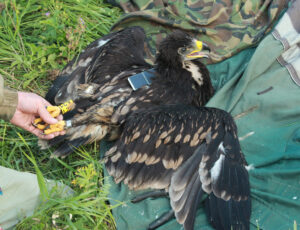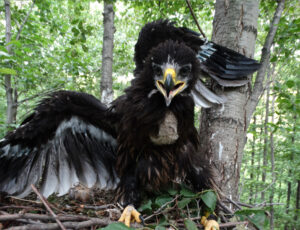Third International Scientific and Practical Conference “Eagles of the Palearctic: Study and Conservation”
Raptors Conservation. Suppl. 2. Proceedings of Conferences
“ECOLOGICAL TRAPS” AND “FEEDING OASES” AT WINTERING GROUNDS AND MIGRATIONS OF YOUNG GREATER SPOTTED EAGLES
Mischenko A.L. (A.N. Severtsov Institute of Ecology and Evolution of the Russian Academy of Sciences, Moscow, Russia)
Sukhanova O.V. (Russian Society for Bird Conservation and Study, Moscow, Russia)
Sharikov A.V. (Moscow Pedagogical State University, Moscow, Russia)
Melnikov V.N. (Ivanovo State University, Ivanovo, Russia)
Bekmansurov R.H. (Kazan Federal University, Elabuga Institute, Elabuga, Russia)
Tennhardt T. (NABU, Berlin, Germany)
Zӧckler C. (NABU, Berlin, Germany)
Contact:
Aleksander Mischenko almovs@mail.ru
Olga Sukhanova olga.redro@gmail.com
Aleksander Sharikov avsharikov@ya.ru
Vladimir Melnikov ivanovobirds@mail.ru
Rinur Bekmansurov rinur@yandex.ru
Thomas Tennhardt thomas.tennhardt@nabu.de
Сhristoph Zӧckler christoph.zoeckler@m-h-s.org
Recommended citation: Mischenko A.L., Sukhanova O.V., Sharikov A.V., Melnikov V.N., Bekmansurov R.Kh., Tennhardt T., Zӧckler C. “Ecological Traps” and “Feeding Oases” at Wintering Grounds and Migrations of Young Greater Spotted Eagles. – Raptors Conservation. 2023. S2: 40–44. DOI: 10.19074/1814- 8654-2023-2-40-44 URL: http://rrrcn.ru/en/archives/34859
The present study is based on data on the spatial distribution, habitats used and limiting factors during wintering, migration and summer movements for 9 young Greater Spotted Eagles (Aquila [Clanga] clanga, GSE) obtained via GPS-GSM tracking. In 2019, 4 individuals (Oduvanchik, Boets, Zadira, Klyazma) were tagged in the center of European Russia and 1 (Prosha) in the Republic of Tatarstan; in 2022 – 3 individuals in the center of European Russia (Leto, Dina, Tisha) and 1 (Kirya) in the Chuvash Republic.
Scant published data based on telemetry indicate that young GSEs migrate to wintering sites independently, using different route than their parents (Meyburg et al., 2005). Apparently, the first autumn migration of young individuals does not yet have a strict direction and is largely a matter of chance (Maciorowski et al., 2014). We confirmed this by tracking our GSEs: some of them accidentally found "feeding oases" on migration routes and in wintering areas, while others fell into "ecological traps". Having memorized the location of the "feeding oases" discovered on the migration in the first autumn, birds can change the wintering grounds in subsequent years, settling for the winter in these territories. So, in October 2019, Oduvanchik made an 18-day stopover in the area of Slavyansk-on-Kuban in the Krasnodar Territory. The next three winters, he spent on Prikubanskaya Plain, without further migration to the delta of the Nile River, where he spent the first winter. Another eagle named Prosha, during the first winter stayed for a month (from 25/10 to 24/11/2019) on Salyan Plain of Azerbaijan, mainly in swampy areas not used in agriculture. Then he flew along the western coast of the Caspian Sea to the south and settled in Gilan province of Iran. During the two subsequent wintering, Prosha did not stay in Azerbaijan. Favorable combination of habitats in the winter territory of Prosha in northwest Iran and the rice fields with easily accessible prey for Oduvanchik on Prikubanskaya Plain (see the theses of Mischenko and Sukhanova in this book) results in the minimum wintering areas and the smallest average daily movements of these two birds. Unlike them, Dina and Zadira ended up wintering in "ecological traps" – deserts. Dina died in Saudi Arabia 18 days later. Zadira, who also wintered in the Arabian Peninsula and the coastal pains of the Persian Gulf, was able to survive, but was forced to make the greatest daily movements in search of food. The places of the longest stopovers of Oduvanchik and Boets during summer vagrancies were the territories with extensive farmlands in Bezhetsk district of Tver region (60 days in 2020 and 102 days in 2021) and Orsha district of Belarus (67 days in 2020), in which the terms of harvesting and haymaking are greatly extended. Harvesting kills and displaces many birds and small mammals turning such areas into a “fodder oasis” for raptors, thus they can stay here for long making very short daily movements.
We found that GSEs stop at large landfills, with concentration of Corvidae and gulls, and the abundance of rodents. Oduvanchik spent 9 days, from (28/06 to 06/07/2020) on landfill in near the city of Tver. Boets for a week (from 05 to 12/06/2021) stayed on landfill near the city of Rzhev. Here, on 22/06/2023, we visually recorded a GSE that was not tagged with a tracker.
GSE named Leto discovered an unusual "fodder oasis": an industrial estate with flooded quarries within the city of Kostroma, where an outbreak of avian flu was registered on 18/05/2023. Leto flew to this place on 02/06 and stayed there until 07/07/2023. The abundance of dead and dying birds did not last long, and later the GSE probably began to prey on gull chicks in colonies. Easy access to prey, reduced disturbance (quarantine in the 500 m zone), and the presence of trees convenient for roosting results in minimal movements withing the industrial zone – no more than 1.1 km.
We have identified very high mortality rate of young GSEs as a result of anthropogenic factors: only two of the nine birds remained alive by 2023. Prosha died in a foxtrap with a bait in the Samara region at the 4th year of life. Tisha was killed by a poacher in Abkhazia during the first autumn migration. Poles of power lines in arid zone possess deadliest risk for raptors. Zadira and Kirya perished on them in Iran at the 1st year of life. Dina died in the Arabian desert, probably from lack of food. The reasons for the death of Klyazma in Libya, also at the 1st year of life, and the Boets in Israel at the 3rd year of life are unknown.

Greater Spotted Eagle named Prosha, tagged with rings and GPS/ GSM-tracker from Aquila Company. Photo by R. Bekmansurov.

